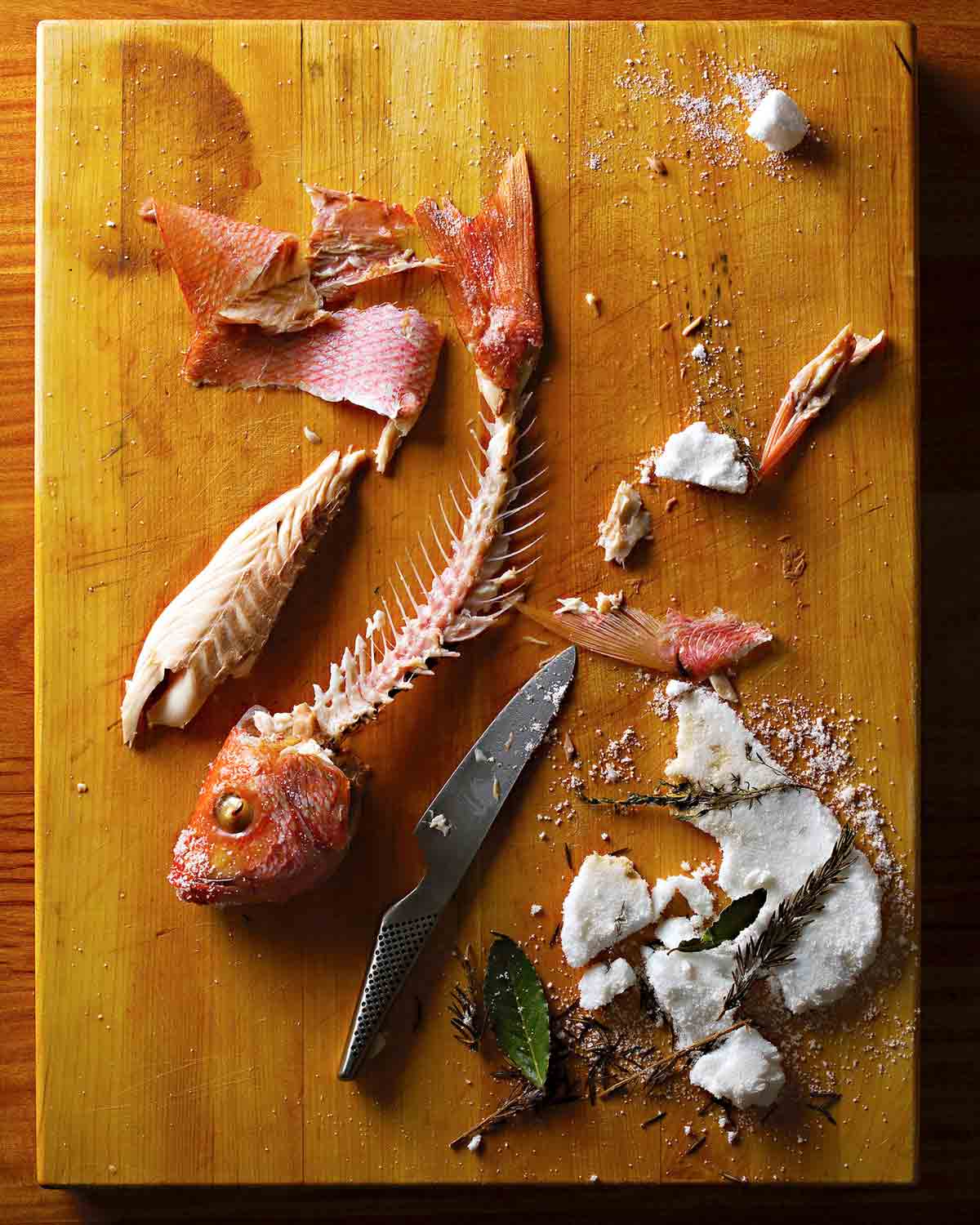
Called lubina a la sal, or salt-baked red snapper, there’s no better or simpler technique for cooking fish than this. The snapper baked inside the salt shell is soft and moist, with no hint of saltiness, in spite of what you might expect. You normally see this dish in restaurants, but it’s easy to replicate at home. After you make this dish a few times, you’ll discover the right combination of temperature, cooking time, and the weight of the fish to give you a perfectly cooked fish.–José Andres

Salt-Baked Red Snapper
Ingredients
- 3 pounds coarse sea salt, plus more for serving
- 3 tablespoons cold water
- 4 bay leaves
- 6 rosemary sprigs
- 10 thyme sprigs
- 1 (2 1/2-pound) whole red snapper, gutted but not scaled
- 2 tablespoons extra-virgin olive oil, preferably Spanish, if desired
Instructions
- Preheat the oven to 375°F (190°C) and adjust the oven rack to the middle position.
- In a large bowl, toss the salt with the water, stirring until the salt is slightly damp. Coarsely chop 2 bay leaves, 3 rosemary sprigs, and 5 thyme sprigs. Add the aromatics to the salt and mix well.
- Spread half of the mixture on a rimmed baking sheet. Place the snapper on the salt. Tuck the remaining herbs in the cavity of the fish and then cover the fish completely with the remaining salt mixture, packing it firmly around the fish.
- Bake the snapper for 30 minutes. (If your fish is larger than 2 1/2 pounds, increase the oven time approximately 5 minutes or so per each extra pound.) Let the snapper rest for 5 minutes.
☞ TESTER TIP: Instead of trying to balance temperature, time, and weight to figure out the right combination for cooking, simply use an instant thermometer inserted through the crust into the center of the fish. At a temperature of 145°F, the fish will be perfectly done.
- Using a fork and spoon, crack open the salt crust along the side. The upper half of the salt, now a hard shell, should lift off easily. (Although truth be told, it may crumble into pieces.)
- With the help of a fork, gently peel away the snapper’s skin and discard. Using a knife, cut just below the head of the snapper through to the bone. Then turn the knife at an angle and slice lengthwise along the spine. Carefully lift the fish fillet off the bone in a single piece, if you can, and transfer it to a platter. Turn the fish over and repeat on the other side. The fish should flake easily and be opaque throughout.
☞ TESTER TIP: Or, instead of fussing with this, you could instead simply transfer the entire baking sheet to the table and allow everyone to have at the fish with their forks.
- Take a nibble of the snapper and, if you’re so inclined, season it with salt and oil prior to serving.

Explore More with AI
Nutrition
Nutrition information is automatically calculated, so should only be used as an approximation.
Recipe Testers’ Reviews
In a word: divine. Flaky and herb-infused, you barely need the salt and olive oil to finish this dish. Salt-baked fish is always impressive, and this particular rendition is no exception.
If your oven runs cool or you have a fish larger than the suggested 2 1/2 pounds, compensate accordingly by cooking an extra 3 to 5 minutes to be on the safe side (if it’s closer to 3 pounds, make it an extra 8 minutes or so). The fish is easy to present, but be careful when removing the top crust—if you didn’t make it thick enough, it may shatter. So practice—you’ll have many opportunities, since you’ll be making this dish again. And again.
Because this recipe calls for a whole fish and 3 pounds of salt, I can see how it would be intimidating. But it’s extremely easy and, quite possibly, foolproof. Once the fish is cooked, the salt lifts off fairly easily. And the fish tasted sweet and moist—succulent, I dare say.
Two caveats: the recipe says to season the fish with salt after it’s filleted. Mine didn’t need additional salt. Secondly, my fish was just under 2 1/2 pounds, but there’s no way it would have served four people. In our case, it served two adults and one child perfectly.
Contrary to what one may think, the salt crust doesn’t season the fish. But it does provide two big favors: it makes for a great presentation, and it keeps the fish super-moist. The flavors of the fish and the herbs were equally delicate and enjoyable.
My snapper was just under 2 1/2 pounds after gutting, and the amount of salt and the baking time were perfect for it. I allowed myself a little wiggle room in terms of where to put the herbs: half of the aromatics in the cavity of the fish, and the rest between the fish and the top half of the salt crust.
This is a quick and easy recipe, and the results are outstanding. It’s moist and wonderfully flavorful, and I can see using this method with a number of other whole fishes such as branzino, orata, or bass.
The recipe calls for sprigs of rosemary and thyme, which were difficult to incorporate into the salt—not to mention make it more likely that the crust will crack—so I chopped the herbs and blended them with the salt. I also placed lemon slices and herb sprigs inside the cavity of the fish, which imparts additional flavor throughout.
I’ve made this recipe with and without the scales on the fish, and the scales definitely protect the fish from absorbing too much of the salt. I didn’t season the snapper with salt because it had just the right amount of saltiness, but I did drizzle over a bit of Spanish olive oil, and it was just the right touch.
TIP: Instead of trying to balance temperature, time, and weight to figure out the right combination for cooking, simply use an instant thermometer inserted through the crust into the center of the fish. At a temperature of 140°F, the fish will be perfectly done.













Hi David – this sounds wonderful – can I use kosher salt instead of sea salt?
Hi Marilyn, yes, you certainly can.
Yes! That is what I typically use. Salt crusted fish is a traditional Passover and Rosh Hashanah dish, so absolutely!!!
Thanks, Sandra.
NOT SCALED????? I really enjoy eating whole fish, including the skin, but it absolutely needs to scaled. What would the reasoning behind not being scaled? Does the skin become saturated with salt while baking?
Hi, Cheryl. Salt-baked fish is never scaled. The scales create an effective barrier against all that salt, otherwise the fish would be inedible.
It gets super salty! The skin prevents the salt from penetrating the fish. That is also why a thick skinned fish is preferred and why fatty fish are to be avoided. The skin peels off very easily after salt crust is removed. Also, I bring the dish to the table in the crust. It makes for a nice presentation! Guests will ooh and aah while you break the crust, remove the skin and lift the filets away from the spine, remove the spine and serve. ?
Nice, Sandra!
Wonderful recipe from José Andrés. Lamentably, in Spanish waters we don’t have red snapper, so here it’s usually made with lubina, sea bass, or dorada, gilthead bream. A sauce, such as aliño (extra virgin olive oil, chopped garlic, chopped parsley, lemon juice), is usually served on the side.
That sounds wonderful. It’s similar to a molho de pitau in Portugal. I’m hungry for fish and it’s only 10:51 a.m.!